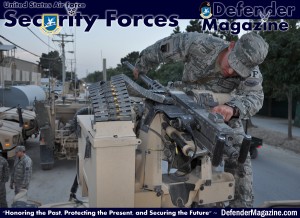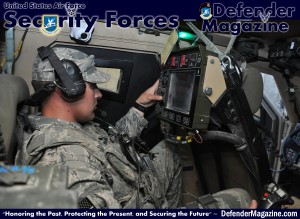6/16/2011 – BAGRAM AIRFIELD, Afghanistan — Bagram is no stranger to indirect fire attacks, but actual assaults by ground forces is few and far between. One of the reasons bad guys rarely come near the wire is because of the 455th Expeditionary Security Forces Squadron’s Quick Response Team.

The QRT’s mission is to provide a security deterrence outside the perimeter at Bagram as well as a mobile reserve for forces inside the wire.
“In the event [Bagram] takes indirect fire, we could be called out to go find a point of origin site and bring the fight to the enemy,” said Tech. Sgt. Michael Parson, 455th ESFS QRT team leader. “We go out and provide a visible deterrence to basically say to the enemy, ‘you’re not coming on our turf.”‘
According to Lt. Col. Thomas Hannon, 455th EFSF operations officer, the aggressive posture of the QRT is not a typical base defense posture but it provides depth to the defense of Bagram.
“Being able to go outside the wire and deny the enemy freedom of movement is huge,” the colonel, deployed from the Rhode Island Air National Guard’s 143rd Airlift Wing said. “They never know when and where we will be.”
Colonel Hannon is a Richmond, R.I. native and explained the QRT uses the total force concept in defending Bagram.
“The QRT works hand-in-hand with designated marksmen who provide cover when they move outside the wire,” Colonel Hannon said. When they’re not moving outside the wire, they’re backing up sectors within the base. It’s a total force effort.”
While the “Reapers,” as they are known, are provided with cover by marksmen when they move outside the wire, the amount of firepower they bring to the battlefield is often enough on its own to discourage insurgents from tangling with them.
“We do have some pretty heavy firepower … as much as you’ll see on any small infantry squad or team,” Sergeant Parson said.

The QRT is typically comprised of several heavily armed assault vehicles and equally heavily armed security forces Airmen. The M240B, M249 and M2 .50 caliber machine gun are just a few of the heavy weapons they bring to the fight.
Additionally, the QRT uses a Common Remotely Operated Weapon Station mounted on the top of the vehicle that allows a gunner to operate a heavy weapon using a video screen and joystick from the safety of inside the armored assault vehicle.
“We are a force to be reckoned with outside the wire,” Sergeant Parson said. “I’d like to think the reason insurgents like to hit us with indirect fire is because they know they can’t get too close. They know they’ll have to deal with the QRT.”
Sergeant Parson is deployed from the Tennessee Air National Guard’s 164th SFS and explained that being ready to perform the QRT mission requires constant training and preparation.
“Training is key,” the Jackson, Tenn. native said. “When we are not pushing outside the wire we are doing battle drills and training. When you’re in a hot situation, training is what will save you and allow you to accomplish the mission.”
Becoming qualified to be on the QRT requires months of stringent training, on top of the standard job training security forces personnel typically undergo.
“Security Forces are always held to a high standard at any base but the QRT are held to an even higher standard,” said Master Sgt. Jose Lopes, 455th ESFS S3 noncomissioned officer in charge. “Their responsibilities are greater and the risks they take are higher. We have to make sure they are prepared for those things.”
In addition to the rigorous training, part of what makes the Reapers so effective is the varied background of its members. There are prior soldiers and marines on the team who add to the knowledge base and expand the capabilities of the elite unit.
“We have a great group of kids on this team that all come together for the same mission and the same goal and they perform it exceptionally,” Sergeant Parson said. “Every person on this team will tell you they have the best job on this base as far as security forces is concerned; they take pride in it.”
Senior Airman Tyler McEuin, 455th ESFS QRT CROWS operator, said his job is very rewarding and he’s grateful for the opportunity to be on the team.
“Every security forces Airman does their part, but this is something you don’t get to do every day,” the Airman from Oklahoma City said. “This is special.”
“They are the best in the Air Force,” Colonel Hannon said of his QRT Airmen. “They are critical to base defense. We have an awesome team here. They do an outstanding job and they are second to none.”
by Staff Sgt. John Wright
455th Air Expeditionary Wing Public Affairs
~